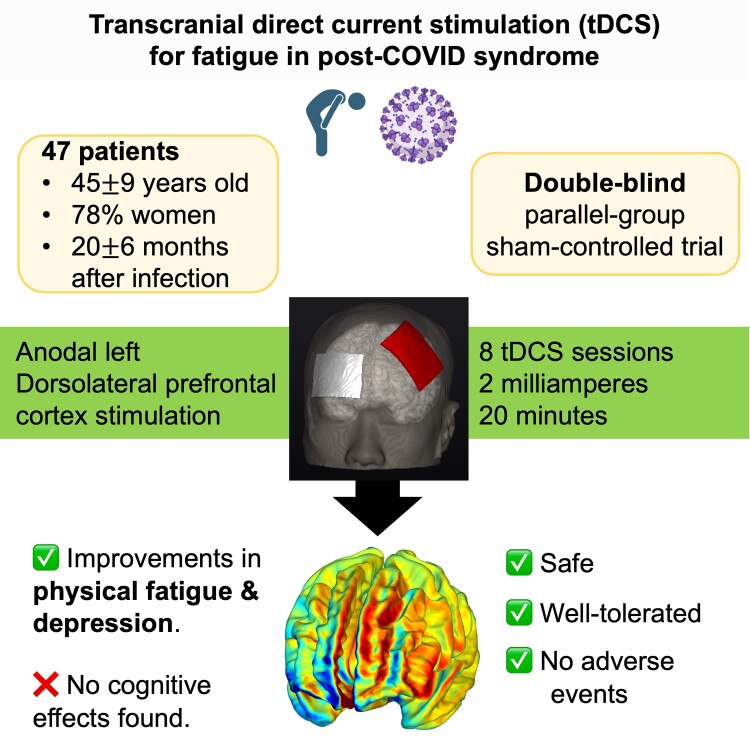- Record: found
- Abstract: found
- Article: found
Transcranial direct current stimulation for post-COVID fatigue: a randomized, double-blind, controlled pilot study

Read this article at
Abstract
Fatigue is one of the most frequent and disabling symptoms of the post-COVID syndrome. In this study, we aimed to assess the effects of transcranial direct current stimulation on fatigue severity in a group of patients with post-COVID syndrome and chronic fatigue. We conducted a double-blind, parallel-group, sham-controlled study to evaluate the short-term effects of anodal transcranial direct current stimulation (2 mA, 20 min/day) on the left dorsolateral prefrontal cortex. The modified fatigue impact scale score was used as the primary endpoint. Secondary endpoints included cognition (Stroop test), depressive symptoms (Beck depression inventory) and quality of life (EuroQol-5D). Patients received eight sessions of transcranial direct current stimulation and were evaluated at baseline, immediately after the last session, and one month later. Forty-seven patients were enrolled (23 in the active treatment group and 24 in the sham treatment group); the mean age was 45.66 ± 9.49 years, and 37 (78.72%) were women. The mean progression time since the acute infection was 20.68 ± 6.34 months. Active transcranial direct current stimulation was associated with a statistically significant improvement in physical fatigue at the end of treatment and 1 month as compared with sham stimulation. No significant effect was detected for cognitive fatigue. In terms of secondary outcomes, active transcranial direct current stimulation was associated with an improvement in depressive symptoms at the end of treatment. The treatment had no effects on the quality of life. All the adverse events reported were mild and transient, with no differences between the active stimulation and sham stimulation groups. In conclusion, our results suggest that transcranial direct current stimulation on the dorsolateral prefrontal cortex may improve physical fatigue. Further studies are needed to confirm these findings and optimize stimulation protocols.
Abstract
In a randomized, double-blind, parallel-group and sham-controlled study, Oliver-Mas et al. find that eight sessions of anodal transcranial direct current stimulation on the left prefrontal dorsolateral cortex improve physical fatigue in patients with the post-COVID syndrome, with no adverse events.
Graphical Abstract
Related collections
Most cited references60
- Record: found
- Abstract: found
- Article: not found
Development and preliminary testing of the new five-level version of EQ-5D (EQ-5D-5L)
- Record: found
- Abstract: found
- Article: not found
A clinical case definition of post-COVID-19 condition by a Delphi consensus

- Record: found
- Abstract: found
- Article: found
